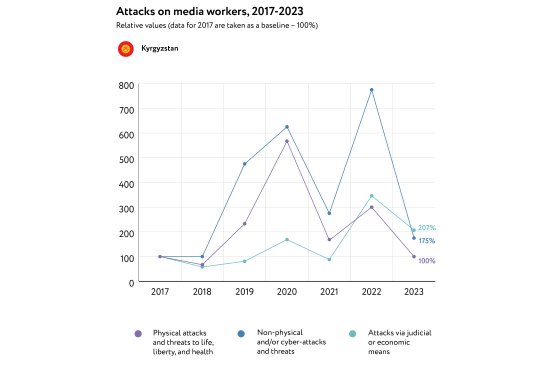 The year 2023 in Kyrgyzstan was marked not only by increased political censorship but also by a crackdown on the media and civil society amid the parliamentary review of two bills: the law "on NGOs” (similar to the Russian "foreign agents” legislation) and law "on mass media”. On 22 February 2024, the law "On NPOs” was adopted after a second reading. The law "on mass media” provides for a number of excessive restrictions, including state regulation of the media and online platforms and sanctions for "abuses of freedom of speech.” As a result, the persecution and harassment of independent media workers who are critical of the government has notably intensified. In addition, an unconstitutional ban on peaceful assembly was introduced.
The year 2023 in Kyrgyzstan was marked not only by increased political censorship but also by a crackdown on the media and civil society amid the parliamentary review of two bills: the law "on NGOs” (similar to the Russian "foreign agents” legislation) and law "on mass media”. On 22 February 2024, the law "On NPOs” was adopted after a second reading. The law "on mass media” provides for a number of excessive restrictions, including state regulation of the media and online platforms and sanctions for "abuses of freedom of speech.” As a result, the persecution and harassment of independent media workers who are critical of the government has notably intensified. In addition, an unconstitutional ban on peaceful assembly was introduced. This handbook explains how internet shutdowns undermine democractic elections and provides tips and recommendations for key actors to navigate shutdowns and understand and assess the extent to which an election taking place under a shutdown is free and fair. It is aimed at election observers, people on diplomatic missions, journalists, and human rights activists in particular. Last update of this handbook was in April, 2021. A PDF version of this handbook is available for download here.
This handbook explains how internet shutdowns undermine democractic elections and provides tips and recommendations for key actors to navigate shutdowns and understand and assess the extent to which an election taking place under a shutdown is free and fair. It is aimed at election observers, people on diplomatic missions, journalists, and human rights activists in particular. Last update of this handbook was in April, 2021. A PDF version of this handbook is available for download here.
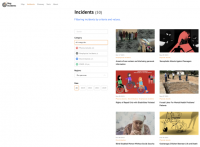 The monitoring group of
the School of Peacemaking has presented analytical results of the documented
incidents.
The monitoring group of
the School of Peacemaking has presented analytical results of the documented
incidents.
The research data was collected in 2023 by both specialist researchers and monitoring methods using open-source content in the Kyrgyz and Russian languages.
The Mapincidents in Kyrgyzstan is an open data resource, a tool for analyzing the situation and collecting cases. Statistics in the Incidents section display the number of incidents for each individual category.
This web resource displays only facts that have been documented by experts from the School of Peacemaking, the Coalition for Equality in the Kyrgyz Republic and have a certain context in the form of a media story. Many incidents remain unknown for various reasons. Based on the collected information, various reports are compiled. The final 2023 report will be published in 2024.
Photo: Screenshot of the web resource mapincidents.net
Attacks via judicial means has remained the main method of exerting pressure on professional and civilian media workers, and editorial offices of traditional and online media outlets, experts said.
This media risk has been identified for the last years.
The monitoring group of the School of Peacemaking summed up the preliminary analysis’ results of incidents against journalists and bloggers.
In 2023, more than 50 attacks on freedom of speech/expression were recorded in Kyrgyzstan. Most of these incidents were done using judicial methods: the interrogations, arrests, pre-trial detentions, threats, blocking e.t.c.
The researchers also note that decreased perceptions of freedom of expression in the local context had an impact on incidents against media workers.
This is due to various restrictions, including freedom of peaceful assembly, strict legislative initiatives against NGOs, the initiation of a new restrictive law "On the Media,” and the growth of censorship and self-censorship.
The School of Peacemaking and Media Technology in partnership with the Justice for Journalists, has been constantly monitoring and analyzing incidents that are published on the Media Risk Map since 2017.
The full report, "Attacks on media workers in Kyrgyzstan,” will be available in 2024.
The School of Peacekeeping and Media Technologies in Central Asia, together with leaders from Justice for Journalists, has been constantly monitoring and analyzing incidents that are published on the media risk map since 2017.
The full report, "Attacks on Kyrgyz media workers,” will be available in 2024.
Previous year's report here
Canva illustrative image.
 Pressure on media
freedom in Central Asia will continue, says Inga Sikorskaya, founder of the
School of Peacemaking and Media Technology in Central Asia.
Pressure on media
freedom in Central Asia will continue, says Inga Sikorskaya, founder of the
School of Peacemaking and Media Technology in Central Asia.
"The rejection of criticism by the authorities creates narratives hostile to the media and fuels negativity society's attitude towards the media, she emphasized at the international conference "Turning Points in Eurasia: Geopolitics, Economics and Civil Society in Central Asia - Current Situation and Future Prospects,” held in Almaty, Kazahstan.
The authorities of Central Asian countries are passing repressive laws against the media. There has been an increase in attacks and threats against media workers. Moreover, attacks using legal mechanisms predominate.
Another example of the suppression of media freedom is organized actions involving unknown groups of people. For example, in Kyrgyzstan, groups of aggressive people came to the local editorial office of Radio Liberty (Azattyk), online media Kloop and Kaktus. The crowd demanded that these media be immediately closed and declared foreign agents (like to the repressive law of Russia). Otherwise, these "activists” threatened that they would burn down the editorial offices.
You can watch the videohere
 The report showsthe attacks/threats
against professional and civilian media workers, and editorial offices of
traditional and online publications. These were identified and analysed in the
course of the research for 2022.Data for the research, carried out over
the course of 2022, was collected using open source content in three languages:
Kyrgyz, Russian and English.
The report showsthe attacks/threats
against professional and civilian media workers, and editorial offices of
traditional and online publications. These were identified and analysed in the
course of the research for 2022.Data for the research, carried out over
the course of 2022, was collected using open source content in three languages:
Kyrgyz, Russian and English.
In 2022, authorities carried out unprecedented numbers of attacks on freedom of speech, partly in response to journalists’ ongoing investigations into corruption in Kyrgyzstan. Since 2021, the number of incidents has tripled.
1. Attacks via judicial and/or economic means remain the main method of exerting pressure on media workers, accounting for 70% of the total number of incidents.
2. There was a sharp increase in the number of journalists being arrested, interrogated, and tried in court as a result of their work.
3. In addition to this, the number of cyber attacks against both media outlets and journalists almost tripled.
4. In addition to this, the number of cyber attacks against both media outlets and journalists almost tripled.
The full report can be viewedhere
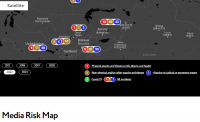 Authorities and society should make efforts to keep
independent media existing in Kyrgyzstan. Therefore, any attempts to toughen
control over media and censor content should be abandoned in the first place.
Authorities and society should make efforts to keep
independent media existing in Kyrgyzstan. Therefore, any attempts to toughen
control over media and censor content should be abandoned in the first place.
The trends demonstrate that the freedom of speech gets worse in the last five years
Experts of the School of
Peacemaking and Media Technology emphasise that dynamics of risks of journalist
activity has changed considerably in five years. 17 incidents against media
workers were reported in 2018, 49 incidents in 2019, 102 incidents in 2020. Their
number declined to 44 in 2021, and the number of attacks increased
significantly in 2022.
According to analysis and documentation of attacks/threats against media workers in Kyrgyzstan, 130 incidents were reported in 2022[1], which is three times more than last year.
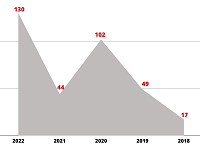 Chart 1. Dynamics
of reported attacks and threats from 2018 to 2022
Chart 1. Dynamics
of reported attacks and threats from 2018 to 2022
Legal mechanisms are used as the key method of pressure on journalists, bloggers and media workers.
In 2022, the number of detentions, arrests, questionings increased as a result of publications in the media, as well as the number of calls of journalists and bloggers for interviews as witnesses.
Threats and online attacks like trolling, bullying, cyber-attacks, including during live broadcasting on social media, are the risks for media workers.
Professional activity and safety of investigative journalists, who shed light on corruption, cover other sensitive topics and demonstrate opposing views in their reports, are at serious risk.
The criminal case against investigative journalist Bolot Temirov and his deportation from Kyrgyzstan last year, arrest and criminal case against blogger Yrys Zhekshenaliev and similar cases confirm these concerns.
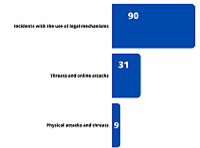 Chart 2. Number of incidents reported in 2022 by categories Blocking of
websites of Azattyk Media, ResPublica, attempted blocking of the website of the
news agency 24.kg in 2022 on formal grounds, based on the law "On fake (false)
information” is the result of the legislation expanding the powers of
authorities to have control over the media landscape.
Chart 2. Number of incidents reported in 2022 by categories Blocking of
websites of Azattyk Media, ResPublica, attempted blocking of the website of the
news agency 24.kg in 2022 on formal grounds, based on the law "On fake (false)
information” is the result of the legislation expanding the powers of
authorities to have control over the media landscape.
The new draft law "On mass media” brought up for public discussion contains such risks. It requires re-registration of all media outlets, imposes restrictions on funding from abroad, and provides for sanctions for unclear "abuse of freedom of speech.”
On the World Press Freedom Day, we demand that the authorities encourage independent journalism, pluralism, diversity of media and abandon pressure on this fundamental human right.
[1] Ongoing monitoring, analysis and documentation of incidents and media risks are held by experts of School of Peacemaking and Media Technologyin CA and Justice for Journalists Foundation, 2017 -2023, https://jfj.fund/risk-map/
The report shows the results of monitoring, documenting and case analysis related to discrimination and violence during the coronavirus pandemic, as well as the study of hate speech against minorities and vulnerable groups in the selected online content.
The report contains the data that cover the period from February 15, 2020 thru March 10, 2021.
The study represents the analysis of cases relating to eleven vulnerable social groups:
· female victims of violence and abduction;
· persons with disabilities, including inmates;
· internal migrants;
· labour migrants;
· the elderly people;
· people living with HIV;
· LGBT people;
· children under 15;
· foreigners victims of racial attacks;
· Muslims;
· ethnic Chinese
In addition, the report contains a separate subsection with the case of Kamil Ruziev, the human rights defender based in Karakol, Issyk Kul region. He was arrested in May 2020 on a reasoned charge and was morally coerced, surveilled and illegally questioned even though he was ill with COVID-19.
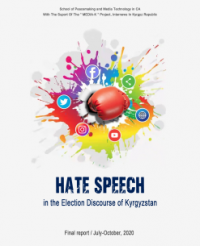 From July 15 to October 10, 2020, the experts of the School of
Peacemaking and Media Technology in CA conducted the "Hate Speech in the
Election Discourse of Kyrgyzstan” study with the support of the USAID-funded Media-K
project and Internews in the Kyrgyz Republic.
From July 15 to October 10, 2020, the experts of the School of
Peacemaking and Media Technology in CA conducted the "Hate Speech in the
Election Discourse of Kyrgyzstan” study with the support of the USAID-funded Media-K
project and Internews in the Kyrgyz Republic.
To successfully counteract hate speech and discrimination during election campaigns, it is necessary to improve the culture of discussion and self-expression and create models for politically correct discourses in the public space and media sphere of Kyrgyzstan.
Diagram 1. Dynamics of detected hate speech over all seven periods of media monitoring, %
The researchers analyzed the trends and dynamics of hate speech detected in the selected online media and social media content. This content was classified by type, and the team identified ten prevailing trends and their causes in each period of media monitoring. Detailed analysis of these trends is provided in the final report.[1]
Diagram 2. Dynamics of trends by kinds of intolerance in media and online discussions in all periods, %
In their main findings, researchers noted
- the lack of quality analytical information about political parties and their platforms and candidates in the media;
- the use of hate speech in relation to the most sensitive issues for the audience on the internet and in the public sphere;
- references to the ethnic and regional affiliations of candidates and their supporters;
- language intolerance in discussions about debates; and
- gender imbalances and hate speech directed at female candidates on social media.
During the study, researchers also recorded instances of trolling, flawed argumentation and identification, accusations toward political parties and their candidates of association with someone else, divisive language, and obscene and coarse language. These phenomena were also detected in visual content.
The experts emphasize that statements and quotes in the election discourse that contained xenophobia created a demand for xenophobic content among the audience, which was expressed in the form of intolerant comments in the forums under news items published online and on social media.
The researchers recommend that authorities:
- take the September 2020 UN Strategy and Plan of Action on Hate Speech into account when developing programs;[2]
- facilitate the speedy adoption of a comprehensive anti-discrimination law in the Kyrgyz Republic;
- develop multilingual models for debates among candidates and public officials;
- train speakers to avoid hate speech and intolerance during election campaigns.
The study authors also urge donor and other international agencies to support ongoing professional monitoring and humanitarian examinations of hate speech in public discourse as well as efforts to develop a new media culture that promotes awareness of non-discrimination in public space and the importance of counteracting hate speech and that supports freedom of expression.
The study’s key recommendations are directed toward journalists and the media. These recommendations focus on the need to update editorial standards, institute exit polls to promote alternative options and develop critical thinking in the audience, and establish rules for quoting speakers who use hate speech in their statements.
"Journalists need to raise public awareness of the language of aggression in the online environment and its impact. It is important to understand network etiquette in online discussions by training voters to perceive the information they have consumed critically,” the recommendations emphasize.
This research has been made possible by the support of the American people provided via the United States Agency for International Development (USAID). The School of Peacemaking and Media Technology in CA is responsible for the content of the publications, which does not necessarily reflect the opinion of USAID, the US Government, or Internews in the Kyrgyz Republic.
About the organization. The School of Peacemaking and Media Technology in Central Asia is an organization for the development of media, public relations, the promotion of freedom of expression, and fighting hate speech and discrimination in the mass media. This organization specializes in media research and expertise on online content; the language of intolerance in the media, the internet, and public discourse; developing media campaigns on sensitive topics; and training journalists, online content developers, and human rights defenders, including in conflict zones.
https://www.facebook.com/peacemakingS/;
[1]Trends by kinds of intolerance, p. 28 of the final issue.
[2] UN Strategy and Plan of Action on Hate Speech, 2020, https://www.un.org/en/genocideprevention/documents/UN%20Strategy%20and%20PoA%20on%20Hate%20Speech_Guidance%20on%20Addressing%20in%20field.pdf, https://www.un.org/en/genocideprevention/documents/advising-and-mobilizing/Action_plan_on_hate_speech_RU.pdf
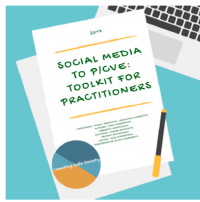 This Toolkit has been created on the basis of the key findings obtained in the framework of the Search for Common Ground (Search) "Social Media for De-Radicalization in Kyrgyzstan: A Model for Central Asia’s” pilot project funded by the Bureau of Counterterrorism, US Department of State. The project is based on two parts: a participatory approach, focused on UN Resolution 22501, and a professional approach aimed at creating and conducting social media campaigns in Kyrgyzstan.
This Toolkit has been created on the basis of the key findings obtained in the framework of the Search for Common Ground (Search) "Social Media for De-Radicalization in Kyrgyzstan: A Model for Central Asia’s” pilot project funded by the Bureau of Counterterrorism, US Department of State. The project is based on two parts: a participatory approach, focused on UN Resolution 22501, and a professional approach aimed at creating and conducting social media campaigns in Kyrgyzstan.
The School of Peacemaking and Media Technology in Central Asia announces an annual competition among students from Kyrgyzstan, Kazakhstan,…

25 journalists and media workers from various regions of Kyrgyzstan have been trained to counter the propaganda of violent extremism and hate in…